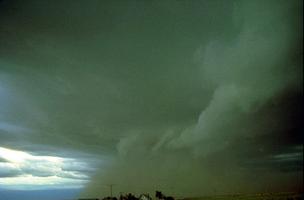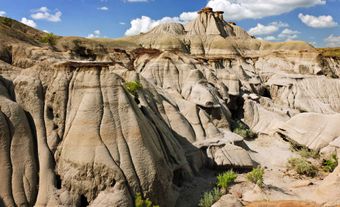Erosion
Erosion is the collective result of all processes that pick up and transport material at or very close to the Earth's surface. The main erosional agents are water, wind, ice and gravity, each of which acts in several ways.Water Erosion
Water erosion, the most complex form, encompasses rain splash, unconcentrated surface erosion by sheetwash or rill wash, channel erosion in rivers or in gullies flowing only during storms, erosion by water flowing through surface materials, and erosion in the shallow zone of lakes and oceans by tides, currents and wave action. Rain splash is rather specialized and is effective only on agricultural fields and exposed loose materials; otherwise, water erosion can be classified as chemical or physical.
Chemical erosion occurs primarily when material is dissolved and transported by water. It depends on such factors as water chemistry, surface materials and temperature. Most commonly its effects are hidden, but up to 70% of the load carried by many rivers is in solution. Where the surface is formed of soluble rocks such as limestone, KARST LANDFORMS develop. In Canada excellent examples occur in the Nahanni region, YT, and in many parts of the Rocky Mountains.
Physical water erosion occurs when moving water achieves sufficient velocity to pick up or move loose particles or to pry fragments loose from SOIL or bedrock. In some rivers this is continual, but in many perennial streams and in gully erosion, sheetwash and rilling, such velocities occur only during rainstorms or snowmelt; therefore, erosion is closely controlled by patterns of storm activity. This is also true in lakes and oceans, but the key factor in these cases is wind force, which generates severe wave action.
Water erosion rates differ greatly with location, depending on the mixture of processes and on the nature of surface materials. Available data on sediment loads in Canadian rivers show a range from below 2 to over 400 tonnes/km2/year. If equally distributed, the upper rate (found in north-central BC) would correspond to a surface lowering of approximately 0.1 mm/year. The actual rate of surface lowering in most parts of Canada is much lower, but in some highly erodible areas, such as the Alberta BADLANDS, measurements have shown surface lowering rates as high as 4 mm per year.
Wind Erosion
Wind erosion acts in essentially the same manner as physical water erosion but, because air is less dense than water, higher wind velocities are required to affect erosion. Theoretically, almost any material is vulnerable but, in practice, wind speed is rarely high enough to move material larger than sand grains, and these only if dry and unbound by vegetation. Significant wind erosion is, therefore, confined almost entirely to coastal areas and to glacial outwash plains and agricultural fields, where vegetation is minimal.
The most severe wind erosion recorded in Canada occurred in the southern Prairies during the prolonged DROUGHT of the 1930s. Vulnerable soils were disturbed by tillage and blown in immense clouds, creating the "Dust Bowl." Erosion was sporadic and varied but surface lowering of 0.5 m in one storm was not uncommon.
Ice Erosion
As ice moves over the surface or is constricted through valleys, it can pluck protruding or loose material away from adjacent surfaces and transport it on or in the GLACIER. This matter joins with material falling onto the glacier and into crevasses to form an englacial MORAINE, which makes the ice an extremely effective abrasive agent capable of planing off surfaces and scouring out valleys. Valley or alpine glaciers tend to increase local relief by scouring valleys while adjacent peaks protrude above the ice.
Continental glaciers spreading over the complete surface tend to reduce relief. Most of Canada was covered by ice during the Pleistocene epoch (2.5 million-10 000 years ago) and excellent examples of both effects are found in many areas. Although glacial erosion now occurs only in the Cordillera and the Arctic, residual features formed during the Pleistocene still dominate most landscapes.
Gravity
Gravity is an important erosional agent because it acts continually on all sloping surfaces. Gravitational stress at any location does not vary, but the resistance of surface materials does alter, particularly in response to moisture changes. Many of the most dramatic movements tend, therefore, to follow prolonged periods of wet weather. By definition, material can only be moved relatively short distances to the base of the original slope, but very large amounts of material can be moved in a few minutes.
Among the classic examples of major gravitational erosion in Canada are the FRANK SLIDE in Alberta (1903), and the Hope Slide in BC (1965), and numerous quick clay slides in the old marine deposits of the CHAMPLAIN SEA in the St Lawrence Valley (seeLANDSLIDE).

 Share on Facebook
Share on Facebook Share on X
Share on X Share by Email
Share by Email Share on Google Classroom
Share on Google Classroom






